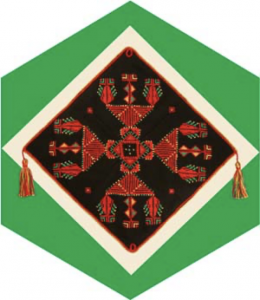Jordan

The Block
Taghreed Sandouka based the design of this block on a sample of Jordanian embroidery. It features a traditional motif of stylized cypress trees cross-stitched in bright tones of red, green and yellow on a black cotton background. In addition to cypress trees, Jordanian embroidery often includes other distinctive symbols, such as camels, moons and wave patterns worked in a repetitive fashion. Such designs are typically used to embellish the bodice, skirt and dress sleeves of women’s garments. Two tassels, like those that have become a popular decoration in Jordan, dangle loosely from either side of the block.
Cultural Profile
The Hashemite Kingdom of Jordan, as it is officially called, is a small Arab country located in the Middle East. The climate is typically warm and sunny although northern mountain areas may get snow in winter. The desert which dominates most of the country, remains hot and dry. The country is home to the Jordan River, which flows into the Dead Sea, the world’s saltiest body of water and lowest point of elevation. Thousands of years ago ancient Semitic civilizations prospered along the fertile shores of the River Jordan. In recent centuries archaeologists have uncovered once-bustling cities buried beneath the sand. Today’s population is overwhelmingly Arab so it is not surprising that Arabic is the national language. English is also widely spoken.
Family is vitally important to Jordanians and is the overarching framework for social organization. Hospitality is a key value in Jordanian culture. Guests are always offered coffee and food when they visit, a tradition called karam, which means generosity. The country has had a peaceful history in recent times, with many different ethnic and religious groups coexisting in harmony. The tradition of hospitality is evidenced as many refugees from Palestine and neighbouring countries, affected by conflicts, have found a welcome in Jordan.
Poetry is an important part of Jordan’s cultural life. The zajal, dating back to the early Arabic period, combines spoken dialogue with music and is a popular form of entertainment. It can be improvised on the spur of the moment and often uses repetition so that listeners can also participate. Bedouin poetry is also central to the culture. The recitations are often accompanied by the rebab, a one-stringed instrument played with a bow.
Traditional craftsmanship is still a large part of Jordanian culture, providing a link to the past. Many women keep the art of embroidery alive by adding exquisite touches to their clothing and household items. Silver and gold work, decorated with cornelian, coral, amber and blue malachite is highly valued. Bedouin women decorate garments in traditional fashion with jangling silver coins and chains. In addition, rugs made from goat hair and sheep’s wool are woven into geometric patterns. These serve as reminders of the nomadic past of Jordanians. Bedouin women weave goat hair into cloth for their Shgaq, tents which can reach up to 12 rooms in size.
Jordanians have been coming to Canada since the early 1900s. They have come to further their education, find gainful employment in their chosen professions or simply in search of new experiences. According to the 2011 census, there were 9,400 people of Jordanian ancestry living in Canada.
Sponsor: Hugh and Bridget Grice
